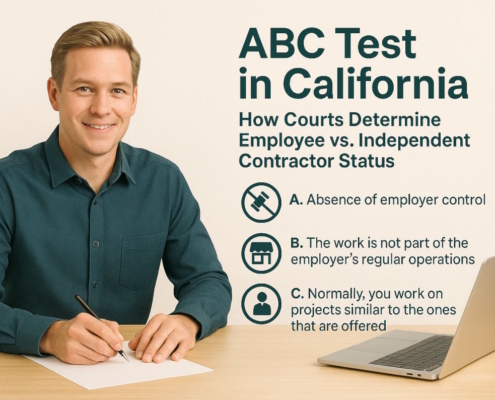Quid Pro Quo harassment vs Hostile Work Environment
Quid pro quo harassment and a hostile work environment are two types of sexual harassment in the workplace. Here’s a brief overview:
Quid Pro Quo Harassment
Quid Pro Quo harassment refers to the situations where a supervisor or someone with authority uses their power to try to coerce an employee into granting sexual favors. For example, a manager threatens to fire an employee unless they go on a date.
Key aspects:
- There is a power differential between the harasser and the victim.
- Tangible employment actions are conditioned on putting up with sexual advances/requests for a long period of time.
Hostile Work Environment
This refers to situations where the unwelcome sexual comments, touching, jokes, etc create an intimidating or offensive working environment. The harassment is severe and is pervasive enough to alter the working conditions. The Equal Employment Opportunity Commission (EEOC) states that “petty slights, annoyances, and isolated incidents (unless extremely serious)” are not considered hostile work environment.
Key aspects:
- May involve co-workers, managers, customers, etc.
- Doesn’t have to include direct threats to the job status
- Makes the workplace feel intimidating, hostile, or abusive
The key difference is that quid pro quo directly leverages the employment actions, while hostile environment covers the broader behavior even without the direct threats. Both can be grounds for a lot of sexual harassment legal charges.
If you’re on a mobile device, turn your phone sideways to view this table:
|
Quid Pro Quo Sexual Harassment |
Hostile Work Environment |
| Definition |
– Job benefits for sexual favors |
– Intimidating, hostile, or abusive work environment due to sexual conduct |
| Examples |
– Promotions for sexual favors |
– Unwelcome advances, derogatory remarks |
| Legal Framework |
– Title VII of the Civil Rights Act of 1964 |
– Title VII of the Civil Rights Act of 1964 |
| Required Proof |
– Direct link to employment decisions |
– Severe or pervasive conduct affecting employment conditions |
| Impact on Victim |
– Direct pressure from power figure |
– Uncomfortable/safe work environment affecting job performance |
| Consequences for Perpetrator/Employer |
– Job termination, legal action for tangible actions |
– Depends on severity, employer’s response; liability if failed to act on known harassment |
Quid Pro Quo harassment
Under the first party’s authority, one party coerces the other into making a sexual offer in exchange for hiring, promoting, or raising a wage; if the second party declines, the first party intimidates to demote, reduce the salary, or even dismiss them.
Its Latin translation is “this for that.” Typically, Quid pro quo harassment is the most obvious. When a worker’s willingness to provide sexual favors in exchange for job rewards like promotions, raises, or preferred work—or for penalizing like being demoted or fired—this happens. Usually, a harasser with command over the victim engages in Quid pro quo harassment.
A solitary “quid pro quo” offer could be construed as harassment under federal laws if it is connected to a benefits package for employment.
Hostile Environment
The term “hostile environment” refers to a workplace where there is a consistent pattern of inappropriate sexual behavior. The regulations state that it is “Any undesirable physical or verbal behavior that is severe enough or widespread to interfere excessively with work performance or to create a work atmosphere that is insulting, hostile, or threatening.”
A hostile work environment resulting from improper sexual harassment is created when one party unreasonably impinges on the victim’s ability to perform their job, purposefully puts the victim in a position of intimidation or hostility, or places the victim in an unfriendly, obscene, and unpleasant workplace. Nonverbal, physical, visual, and verbal conduct are all possible.
When evaluating the validity of a claim of hostile environment harassment, courts consider the following factors:
- Whether the harassment was physical, verbal, or both;
- How often it occurred;
- How hostile or obviously offensive it was;
- If the accused harasser was a manager or a fellow employee;
- Whether other people participated in the harassment;
- Whether it was directed at more than one person or specifically targeted the victim.
Sexual Harassment Forms
A large portion of sexual harassment stems from actions deemed “unwelcome.” Behavior that is neither desired nor requested by the person who has offended is considered unwelcome behavior.
The way the offended party perceives the behavior matters, not the intention behind it. Whatever the motivation, saying “It wasn’t intentional on my part.” does not excuse or confirm the alleged harassment activity.
In order to determine whether a certain behavior is unlawful, courts apply the “Reasonable Person” criterion, which looks at ‘Would a reasonable person find it terribly or overwhelmingly offensive, if comparable conditions were to arise?’
There are several ways that sexual harassment can appear, including written, verbal, visual, and physical abuse.
Verbal
For the most part, written or verbal forms of sexual harassment are the most readily apparent and frequently encountered. A few examples could be:
- Offensive jokes that are sexist or have a sexual theme
- Repeatedly asking for unwanted sexual favors
- Repeatedly asking for dates
- Excessively flirting
- Threatening to take adverse employment action if requests for sexual favors are denied
- Unwanted compliments that have a sexual theme.
You will note that excessive and persistently unwanted behavior is a feature of this type of sexual harassment. Though it would not qualify as sexual harassment, a single verbal or written event could nevertheless go against the professional workplace code. However, if one instance is severe enough—for example, demanding sex in order to maintain employment—one instance can qualify as sexual harassment.
Technology is the main thing to be cautious of these days. A pornographic or suggestive email, for instance, could be forwarded by one employee to others in the office, even if the sender may not have intended for it to be seen by everyone.
Physical
Physical harassment can occasionally be quite subtle, making it a little more difficult to identify. When a sufferer is touched improperly, it is considered physical harassment in the context of sexual harassment. The fact that the victim is handled against their will is the most crucial aspect.
Some instances of touching could be:
- Touching, which includes massaging someone on any area of their body without their consent.
- Playing with someone’s hair.
- Using a sexual touch to caress someone’s hand, arm, or any other portion of their body.
- Establishing sexually suggestive physical touch with someone else.
- Pressing one’s body up against a victim.
- Profane hand motions or other gestures that are intended to be used in conjunction with swearing.
- Careless handling of a person or their belongings.
- Consistently trailing someone or purposefully getting too near to them.
- Using expressions on your face that imply sexuality.
- Playing music that uses derogatory or harmful language.
Visual
Visual sexual harassment is probably the hardest to spot because it’s the most subjective and really requires you to put yourself in the shoes of a reasonable person.
Some instances could be:
- Wearing apparel with inappropriate or unpleasant language
- Showing sexually suggestive posters or pictures
- Showing others sexually suggestive emails or texts
- Drawing violent or disparaging imagery
For instance, a funny message that someone has placed on display at their desk may be humorous to many people, but it may offend some. Both HUD and the courts have long recognized that Title VIII of the Civil Rights Act, (42 U.S.C. 3601 et seq. ) (Fair Housing Act or Act) prohibits harassment in housing and housing-related transactions because of race, color, religion, sex, national origin, disability,[] and familial status, just as Title VII of the Civil Rights Act of 1964 (42 U.S.C. 2000e et seq.) (Title VII) prohibits such harassment in employment.
Reporting Harassment
Anybody experiencing or witnessing what they perceive to be discriminatory or harassing behavior ought to report it to their direct supervisor, some other manager, the HR department, labor commission, or labor board, the executive director or chair. Even if the individual making the claims is not asking for or desiring a probe, all reports of discrimination and harassment must be looked into.
A sexual harassment report is regarded as a complaint. Upon receipt of a complaint, the manager ought to swiftly notify the HR department of their agency. In order to establish the truth, human resources will typically become involved and look into the charges.
These points should be included in the written or verbal complaint, which can be filed either way.
- The identity of the individual who filed the complaint, as well as the name of the victim if they are not the same person;
- The identities of all those who were involved, including any witnesses;
- The employee should provide a clear and comprehensive account of the alleged behavior or action that they perceive to be discriminatory or harassing;
- The date or duration of the alleged behavior;
- An explanation of the intended remedy.
Bystander Intervention
Here are a few tips for bystander intervention when witnessing potential quid pro quo harassment or a hostile work environment:
Step 1: Observe Situations That Could Be Problematic
While certain situations are readily apparent, others are more accurately described as high-risk or problematic behaviors that have the potential to worsen. These instances include:
- Unusual or reclusive actions.
- Restrictive actions.
- Making crude jokes or remarks that are sexist or have a sexual overtone.
- The excessive and unwanted flirtation.
- Paying inappropriate, sexually suggestive remarks.
- Engaging in sexually suggestive physical touch.
- Pressing one’s body up against someone.
- Making obscene hand gestures or other motions with the intention of uttering profanity.
- Using facial expressions that imply sexual activity.
Step 2: Determine When to Step in and Take Action
The next stage is to consider the circumstance to be a problem that requires attention.
Is there affection between the two individuals standing near to one other, or is one of them acting aggressively or intimidatingly against the other? Has your colleague appeared depressed for longer than a couple of weeks? Are they attempting to avoid a particular person all the time?
You might need to obtain further details by:
- Observing the circumstances
- Verbally verifying the information.
- Inquiring as to what others have observed.
Even if you might not be the one to take immediate action, you can still assist in finding the best solutions by recognizing problems.
Step 3- Acknowledge Individual Accountability for Intervention
Here, the crucial question is, “Do I have to take action?” It’s simple to think that someone else will step in to save you the trouble.
When a problem calls for our assistance, we are most likely to notice it if:
- There is nobody else in the area; or/and
- We have a personal connection to the problem. If we found ourselves in that situation, we would seek assistance, or we are aware of the potential consequences if the situation persists.
It can be necessary for you to assist in getting things done, even if it appears like it’s “none of my business” or that some other person should step in.
Step 4: Understand When to Step in
In order to create helpful effective interventions, this step entails learning a variety of skills and tactics. Understanding how to step in safely and efficiently enhances our capacity and readiness to do so.
Step 5: Make an Intervention
When it is about stepping in, there are several choices. You can select the way or approaches that best suit the specific scenario and your confidence level by becoming knowledgeable about a variety of indirect and direct methods.
Methods for Intervention
You will find some techniques in this part of the article to help you step in when you see someone engaging in sexual harassment. There are four main methods of intervention: direct intervention, distraction, delegation and delay,
In response to sexual harassment, you might want to oppose the harasser or describe the situation to let them know. It could be dangerous to use this strategy because the harasser might turn the attention back to you and make things worse. Examine the circumstances before choosing a direct intervention: Do you feel safe physically? Is the victim of harassment in a safe physical environment? Is there any reason to believe that things will not get worse? Does the target of the harassment want you to speak up? You may choose to respond directly if you can affirmatively answer each of these questions.
If you decide to step in and stop them, you can tell the harasser things like:
-
- “That’s not acceptable, indecent, improper, etc.”
- “Don’t bother them.”
In this case, keeping things brief and to the point is crucial. Avoid having discussions, debates, or arguments because this is how things tend to get out of hand. If the harasser answers, make every effort to help the victim rather than interact with the harasser. Use caution when using direct intervention as it can be dangerous.
A more subtle and inventive method to step in is through distraction. Simply said, the goal is to disrupt the situation in order to derail it. Ignore the attacker/harasser and talk to the individual who is being harassed directly instead of ignoring them.
Refrain from discussing or bringing up the harassment. Instead, engage in utterly irrelevant conversation. You could attempt the following:
-
- If you could discuss a work-related matter with them, ask them. Request the time. Distract the harasser by striking up a conversation with them about anything at random.
- Obstruct the path. Get in the way of the harasser and the victim while carrying on with your current task.
- Unintentionally spill your tea or cause a disturbance.
Obviously, consider the circumstances before selecting your diversion strategy. Your actions or words should defuse the situation once the target of your abuse realizes that they are being targeted.
A third person, typically an authority figure, is involved in delegation. Bring your boss, the HR department, or the safety in-charge into the matter.
After the incident has happened, follow up with the person who was harassed to check if there is anything that can be done to support them. This is known as delay. Even though you may not have been present when the incident occurred, you witness someone who appears to be really unhappy,
If you follow up with the harassed individual after the incident, you can still have an impact on them even if you are unable to take immediate action. Many forms of harassment occur briefly or very fast; in these cases, you can speak with the victim after the incident. Here are some strategies for employing the delay method in an active manner:
-
- Express regret for what occurred to them and ask whether they’re alright.
- Find out whether you can help them out in any way.
- Offer to go with them where they’re going or to spend some time sitting with them.
- Assist them in creating a report if they so choose and provide resources to them.
- To find out if they would like you to submit them the documentation you made of the incident
The secret is to be prepared, regardless of your strategy. Plan ahead and choose a course of action that you believe you can follow. You can make decisions more rapidly in tense situations if you practice. Also, customize your bystander tactic to match your personality and attitude.
There is much more to bystander intervention than these four Ds. Be imaginative. Start carefully and modestly. Hear a joke that is racist? It’s preferable to give the joketeller a disgruntled face than to follow along and chuckle. Sometimes a loud sigh can prevent the next joke from arriving.































